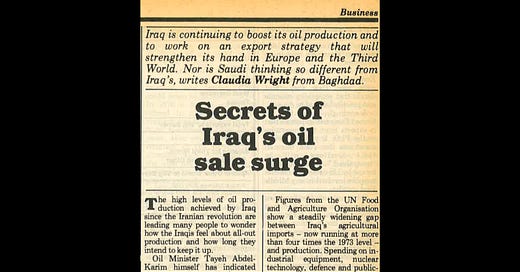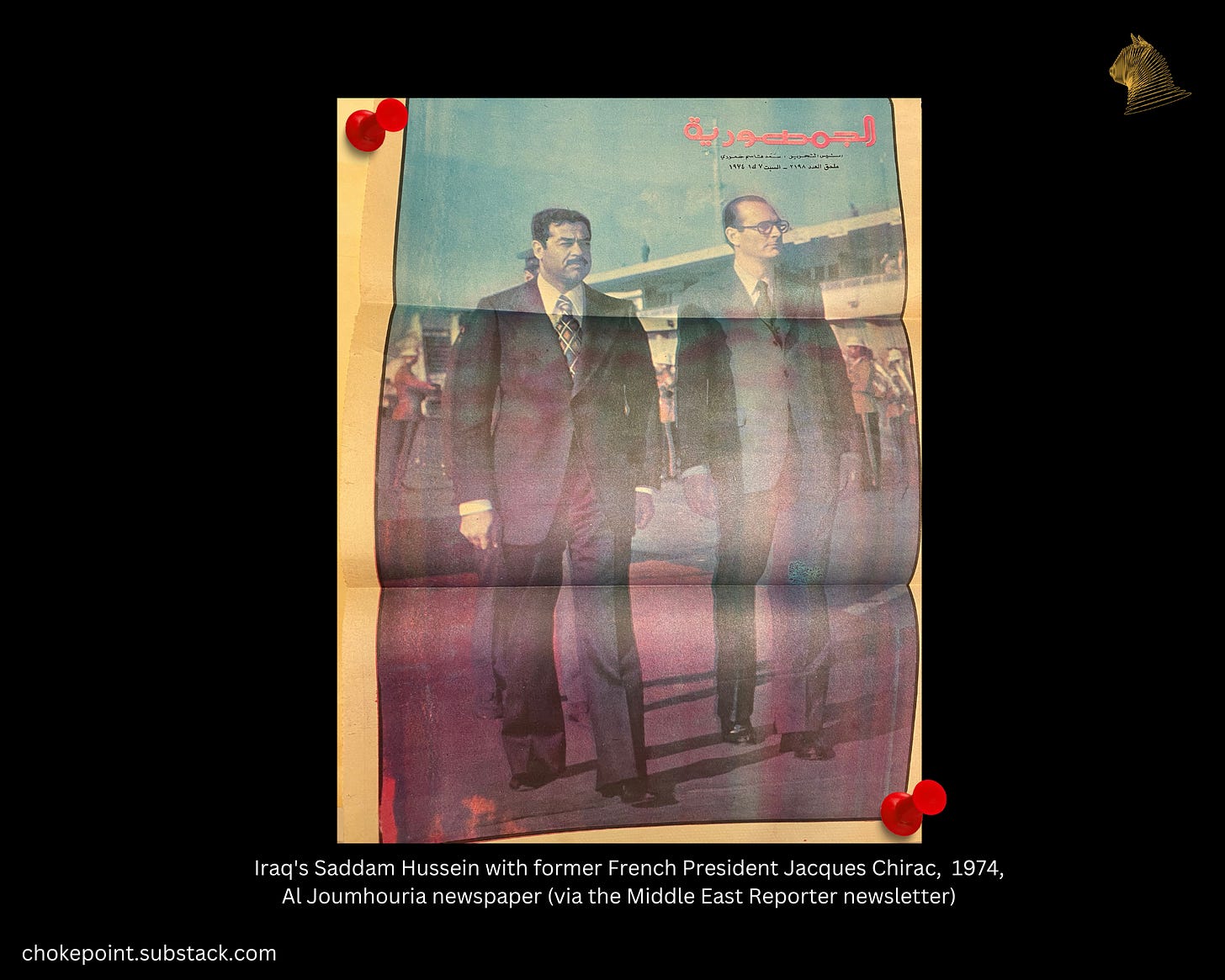Iraq 1980: Strategy for Oil Exports to Europe, and the Threat of US Stockpiles
Hello there, Noam here.
The “Secrets of Iraq’s Oil Sale Surge” – this is an article written by Claudia Wright and published by the Middle East magazine in August 1980. At that time, and according to the piece, Iraq was focused on boosting oil production, and shaping “an export strategy that will strengthen its hand in Europe,” as well as in some countries in northern and southern Africa, and other places. Today, I share with you parts of this report because it is one of those historical documents that capture major events during a critical period in history.
‘Baghdad Expects Some Acknowledgement’
“We decided to ensure France’s oil supply whatever the circumstances,” Claudia Wright quoted Iraqi oil minister Tayeh Abdel-Karim as saying in 1980, when demand from major western oil importers was on the rise. That year, Iraq’s production stood at 3.7 million barrels per day (b/d), and the Iraqi oil ministry was “unofficially” planning to ramp it up throughout the following years to reach a maximum daily production of 8 million b/d by the end of 1983.
Iraq’s decision to send extra oil supplies to France was driven by politics— given the French government’s stance at that time towards the Arab-Israeli conflict— and also by the exchange of technology. In addition to exporting more oil shipments to France, Baghdad was also sending oil to countries it viewed as carrying “special strategic importance,” and they included Italy, Portugal, Spain, Greece, Turkey, Cyprus, Tunisia, and Morocco.
Baghdad of course expected more than words from Western Europe in return for the oil supplies.
“If the countries of West Europe believe we are on the right side, then they must decide that something concrete and practical should be done,” the Middle East magazine quoted Iraq’s foreign minister in 1980, Saadoun Hammadi, as saying.
For instance, Iraq expected from the Europeans “more than overtures towards the PLO” (Palestine Liberation Organization) and “formal assurances that NATO forces on their territory will not be ‘neutralized’ – that is, ruled out for use by US forces and defence supplies involved in any Middle East conflict,” wrote the Middle East magazine.
On the issue of the Palestinian cause, Iraqi oil exports to European countries were made conditional on cutting trade not only with Israel but also South Africa. During that period, Baghdad was also working on a strategy to aid “liberation forces” active in African countries, such as Mozambique, and focus on economic relations with northern and southern Africa, according to the deputy oil minister back then Abdel-Jabbar Hassan.
Iraq’s Oil Credits and Aid Development
Iraq’s strategy during those times to build economic ties with some African countries is an interesting development highlighted by the article, particularly with respect to Somalia where Iraq wanted to compete with the US through oil credits and development aid.
Based on the information published by the Middle East magazine, Baghdad’s attempts to discourage Somalia from accepting US “overtures for use of the Berbera naval air base” resulted in at least $40 million in oil credits in direct Iraqi economic aid to Somalia in 1979. Iraq made a similar move towards Kenya where the US wanted to use base facilities in the country, the magazine wrote.
Other African countries like Djibouti were in talks back then with Baghdad to receive Iraqi oil in return for reducing French naval presence on their territories. Even in the Indian Ocean, Iraq “actively courted” the Seychelles where Britain had naval facilities, according to the Middle East magazine.
Iraq was preparing to host the tenth anniversary of OPEC in Baghdad in November 1980, and according to the magazine, the stage was “being set for a more sophisticated use of Arab oil strategy then the US and its allies have yet seen.”
The Threat of US Oil Stockpiles
Another important information carried by the article was about how Iraq saw US oil stockpiles as a threat to OPEC during those times. Given last year’s largest release of oil from the US Strategic Petroleum Reserve (SPR) in history to address high oil prices, some readers, particularly those who follow the energy markets closely, may find this interesting, and for this reason I will share the full section below:
“Iraqis also [emphasize] the threat posed to Opec by US stockpiling. Halted for months by technical problems and then by the tight market conditions after the drop in Iranian production, the filling of the reserve is scheduled to begin again within six to 12 months, or even sooner if Congress has its way.
Current stocks in the reserve are 92mn barrels. The original target in 1977 was 1bn barrels and the plan for 1981 is to fill at a rate of 250,000 b/d. US officials now believe, however, that 500-750mn barrels would probably be enough – that is, if the purpose of the reserve is to protect US consumers against sudden oil-supply disruptions.
But in recent months two new strategies have been suggested in Washington for the reserve. One proposal, discussed by the Secretary of Energy, Charles Duncan, with members of the International Energy Agency (IEA) in April, is for the US to help others if their supplies were to be cut off. From the US point of view the object is to deprive the Arab oil producers of some of their leverage with Europe and Japan.
Another US idea, strongly supported by the oil companies and the Energy Department, is to use the reserve as a buffer stock, intended not only for oil supply crises but also for counteracting Opec price influence and for pushing world prices downwards.
This plan would almost certainly require amendments by Congress in the legislation authorising the reserve. Officials hesitate to go this far for fear of further provoking the Saudis into reducing supplies.”
For those who are not familiar with the history of the US SPR, it was established in the 1970s following oil crises that called for a strategic oil reserve, such as the 1973-74 oil embargo. It was former US President Ford who “set the SPR into motion” on December 22, 1975 when he signed the Energy Policy and Conservation Act (EPCA), according to the US Department of Energy.1
Thank you for reading this post.
If you’re interested in reading more about US oil releases from the SPR in 2022, I recommend the Energy Outlook Advisors Substack newsletter, published by Dr. Anas Alhajji.







